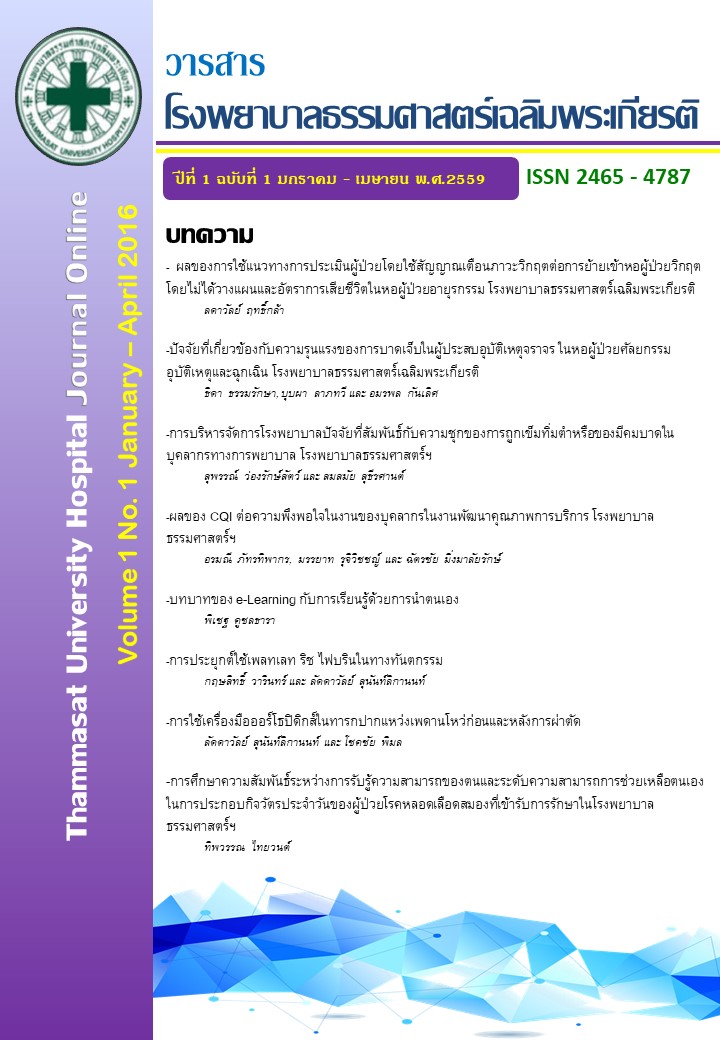Factors Associated with Prevalence of Needle Stick or Sharp Injuries among Nursing Personnel at Thammasat University Hospital
Keywords:
Needle Stick or Sharp Injuries (NSSIs), Nursing PersonnelAbstract
This descriptive research aimed to study prevalence of needle stick or sharp injuries (NSSIs) among nursing personnel and factors associated with NSSIs at Thammasat Universtiy Hospital (TUH). The utilized findings will lead to the reduction of the prevalence of such accidents, in terms of reducing the risk of infection among nursing personnel and increase the safety of patients. The researcher collected data from a sample, 390 nursing staff for TUH over a period of two months with the questionnaires and interviews. Data were analyzed by descriptive statistics such as frequency, percentage, Fisher’s Exact Test and contextual analysis from interview.
The findings concluded that there were two main factors associated with NSSIs: - human factor and environmental factor, statistically significant at the 0.05 level, had occurred under three conditions: carelessness, hastiness and fatigue.
The research proposition pointed that the guidelines to reduce the prevalence of the accident for TUH can be under the policy mechanisms and safety culture in the structure of the physical working environment. Besides, there should be a mechanism to create awareness of the activities within the guidelines set for the nursing staff.
References
งานควบคุมโรคติดเชื้อ. (2555). สรุปรายงานอุบัติเหตุถูกเข็มที่เปื้อนเลือด/ สารคัดหลั่งจากการทำงานของพยาบาลปี 52 – 54 โรงพยาบาลธรรมศาสตร์เฉลิมพระเกียรติ. ปทุมธานี: โรงพยาบาลธรรมศาสตร์เฉลิมพระเกียรติ
จินตนา ตาปิน. (2552). ผลการสร้างแรงจูงใจในการป้องกันการรับรู้ ความคาดหวัง และการปฎิบัติการป้องกันอุบัติเหตุเข็มทิ่มตำหรือของมีคมบาดของบุคลากรพยาบาล โรงพยาบาลชุมชน. วิทยานิพนธ์ปริญญาพยาบาลศาสตรมหาบัณฑิต สาขาวิชาการพยาบาลผู้ใหญ่ คณะพยาบาลศาสตร์ มหาวิทยาลัยเชียงใหม่.
จรรยา ภัทรอาชาชัย. (2554). ชีวสถิติ สำหรับงานวิจัยทางการแพทย์ (ครั้งที่ 2). กรุงเทพฯ: โรงพิมพ์มหาวิทยาลัยธรรมศาสตร์.
ชลธิชา รอดเพ็ชรภัย. (2552). การจัดการความเสี่ยงต่อการถูกเข็มตำหรือของมีคมบาดในบุคลากรพยาบาล งานอุบัติเหตุและฉุกเฉิน โรงพยาบาลธรรมศาสตร์เฉลิมพระเกียรติ. วิทยานิพนธ์ปริญญาสาธารณสุขศาสตร์มหาบัณฑิต สาขาการจัดการอนามัยสิ่งแวดล้อมและความปลอดภัย คณะสาธารณสุขศาสตร์ มหาวิทยาลัยธรรมศาสตร์.
นวลจันทร์ สุพรรณ. (2548). อุบัติการณ์เข็มทิ่มตำและของมีคมบาดกับการจัดการในบุคลากรพยาบาล โรงพยาบาลชุมชนจังหวัดลำปาง. วิทยานิพนธ์ปริญญาพยาบาลศาสตร์มหาบัณฑิต สาขาการพยาบาลด้านการควบคุมการติดเชื้อ คณะพยาบาลศาสตร์ มหาวิทยาลัยเชียงใหม่.
วนิดา คนซื่อ. (2555). ผลการใช้แผนปฏิบัติการจากเทคนิคเอไอซีต่อการปฏิบัติการป้องกันและอุบัติการณ์เข็มทิ่มตำหรือของมีคมบาดของพยาบาล. วิทยานิพนธ์ปริญญาพยาบาลศาสตร์มหาบัณฑิต สาขาการพยาบาลด้านการควบคุมการติดเชื้อ คณะพยาบาลศาสตร์ มหาวิทยาลัยเชียงใหม่.
สมหวัง ด่านชัยวิจิตร และเทพนิมิตร จุแดง. (2540). การป้องกันการถูกของแหลมคมตำหรือบาดในบุคลากรทางการแพทย์. จุลสารควบคุมโรคติดเชื้อในโรงพยาบาลแห่งประเทศไทย, 7(1), 44 – 48.
สุจิตรา เอี่ยมสอาด. (2538). การถูกเข็มทิ่มตำหรือของมีคมบาดจากการให้การพยาบาลของบุคลากรทางการพยาบาล โรงพยาบาลสวรรค์ประชารักษ์. วิทยานิพนธ์ปริญญาพยาบาลศาสตร์มหาบัณฑิต สาขาการพยาบาลด้านการควบคุมการติดเชื้อ คณะพยาบาลศาสตร์ มหาวิทยาลัยเชียงใหม่.
สำนักการพยาบาล กรมการแพทย์ กระทรวงสาธารณสุข. (2546). การป้องกันการติดเชื้อและควบคุมแพร่กระจายเชื้อในสถานบริการสาธารณสุขสำหรับพยาบาล Isolation Precaution. กรุงเทพฯ : องค์การรับส่งสินค้าและพัสดุภัณฑ์
Babcock, H.M. & Fraser, V. (2005). Differences in Percutaneous Injury Patterns in a Multi-Hospital System. Infection Control and Hospital Epidemiology, 24(10), 731 – 736.
Clarke, S.P. (2007). Hospital work environments, nurse characteristics, and sharps injuries. American Journal of Infection Control, 35(5), 302 – 309.
Honda, M., Chompikul, J., Rattanapan, C., Wood, G., and Klungboonkrong, S. (2011). Sharps Injuries among Nurses in a Thai Regional Hospital: Prevalence and Risk Factors. The International Journal of Occupational and Environmental Medicine, 4(2), 215 – 223.
Kedebe, G., Molla, M., and Sharma, H.R. (2012). Needle stick and sharps injuries among health care workers in Gondar city, Ethiopia. Safety Science, 50, 1093 – 1097.
Martins, A., et. al. (2012). Age and years in practice as factors associated with needlestick and sharps injuries among health care workers in a Portuguese hospital. Accident Analysis and Prevention, 47, 11 – 15.
Patrician, P.A., et. al. (2011). Needlestick injuries among nursing staff: Association with shift-level staffing. American Journal of Infection Control, 39 (6), 477 – 482.
Smith, D.R., Choe, M., Jeong, J.S., Jeon, M.J., Chae, Y.R., and An, G.J. (2006). Epidemiology of needlestick and sharps injuries among professional Korean nurse. Journal of Professional Nursing, 22 (6), 359 – 366.
Wicker, S., Jung, J., Allwinn, R., Gottschalk, R., and Rabenau, H. F. (2008). Prevalence and prevention of needle stick injuries among healthcare workers in a German University hospital. Int Arch Occup Environ Health, 81, 347 – 354.



